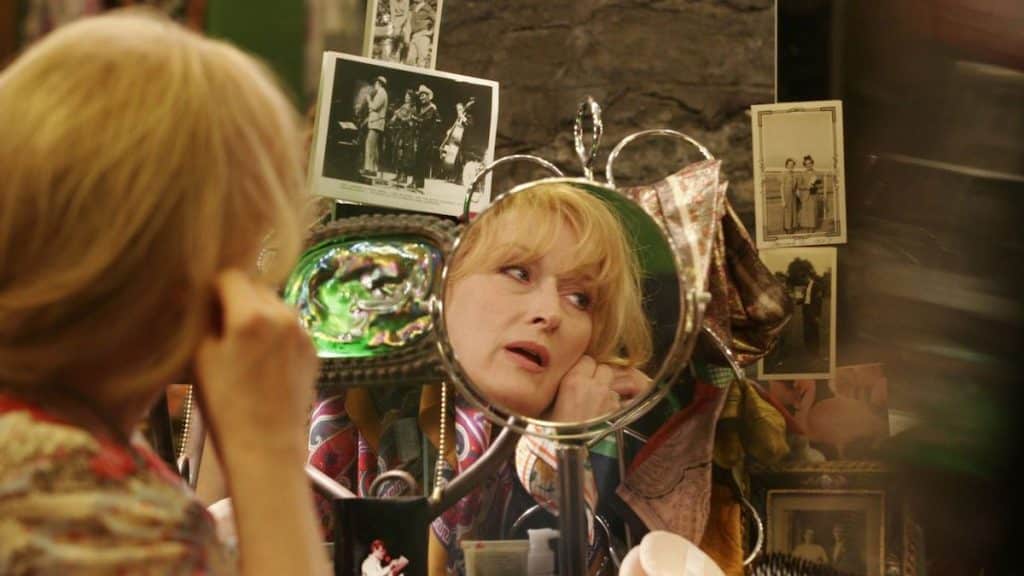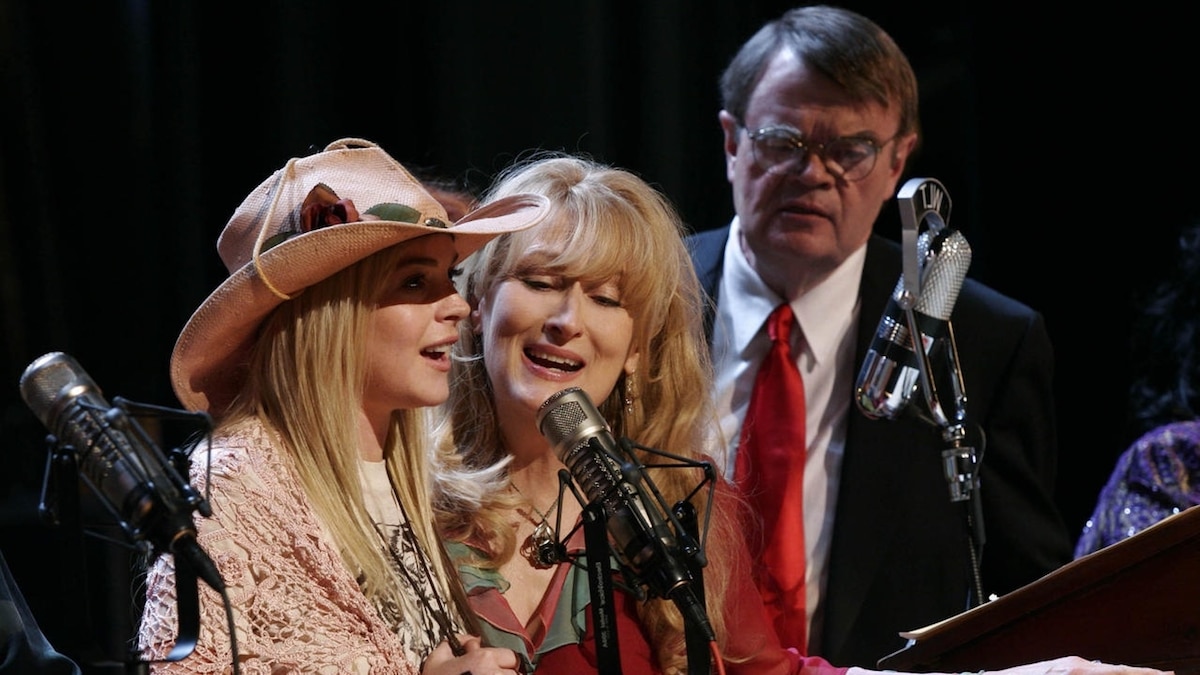Robert Altman’s swan song remains a mesh of spontaneity and character detail further lifted by its ensemble cast.
A few days ago, Quentin Tarantino went on a podcast. The topic of final films came up with him stating he wanted to go out on a high note because, in his view, there had been too many cases of great filmmakers going out with substandard works. Now, this isn’t always the case, but there is a long list of directors who concluded their careers on less-than-stellar works.
If I had to pick one final film from a celebrated filmmaker as the best, I can’t think of a better one than A Prairie Home Companion. The screen adaptation of sorts of the long-running weekly radio show created by Garrison Keillor wound up being the final film from Robert Altman, who passed away a few months after it was released. As a movie, it’s a strange, lovely delight. As a conclusion to one of the defiantly iconoclastic directorial careers of American filmmaking, it not only serves as a more-than-satisfying wrap-up. It also makes the things we consider when judging an artistic legacy—everything from the meanings of life and death to confronting, willingly or not, the passing of an era—the subjects of the film itself.
Did Altman know this would be his last film? He must have realized it was a possibility going in. He had undergone a heart transplant over a decade earlier and his health was poor enough that the only way the film could get financed was if Paul Thomas Anderson agreed to serve as a backup if Altman couldn’t continue working. The fact that he could make any movie under those circumstances is impressive enough. To make one in which Death is not just the focus but also one of the key characters, and make it both joyful and poignant as this, is extraordinary.
The conceit of A Prairie Home Companion is that we’re watching the chaos that is the live broadcast of an episode of the show. In this case, it’s evidently the final show. The long-time owners of the radio station where it’s been broadcast have sold out to a conglomerate. After the final airing, the station is to be razed and turned into a parking lot. However, GK (Keillor), the show’s host, refuses to make a big deal out of this being the final show as a way of getting sympathy. (As he puts it, “Every show is your last show.”) Besides, he’s too busy with his twin jobs of hosting the program and somehow remaining unflappable even as those around him, ranging from the performers to the behind-the-scenes personnel, do things that would send most into severe flappability.

There are Yolanda and Rhonda Johnson (Meryl Streep and Lily Tomlin), the last surviving members of a family act that never quite made it. Yolanda’s suicide-obsessed daughter, Lola (Lindsay Lohan), is also in tow. (When Lola asks who the Carter Family was, her mother replies, “Like us, only famous.”) The other big act is the cowboy duo of Dusty and Lefty (Woody Harrelson and John C. Reilly), who have been together so long that even their backstage bickering comes across like a well-oiled routine. Then there’s Guy Noir (Kevin Kline), one of the actual show’s signature characters, now reduced to working as security. Keeping everyone on their toes is Molly (Maya Rudolph), the heavily pregnant backstage manager who’s not above using her condition as a way of getting people to do her bidding.
As they and the other members of the show’s family strive to pull off the final broadcast, a couple of outsiders make their way to the station as well. One is known only as The Axeman (Tommy Lee Jones), a representative of the aforementioned conglomerate who’s come to ensure the last show goes off without a hitch and, in some others’ eyes, a potential agent of salvation. On the other hand is a white-clad woman (Virginia Madsen), a literal angel of death there to claim one of the show’s most venerable performers (L.Q. Jones) before his assignation with the show’s lunch lady (Marylouise Burke), a long-running affair clandestine to them and seemingly no one else.
Like the vast majority of Altman’s films, A Prairie Home Companion doesn’t have much in the way of a traditional plot structure, but there are plenty of things that happen. There are on-air disasters, but they reveal characters’ pasts in freewheeling and offhand manners that feel just right. If there is a through-line, it’s in the music performances that range from the hilariously ribald songs performed by Dusty and Lefty, much to the eternal chagrin of the show’s Standards guy, to perhaps the only truly appropriate musical coda—the saddest of songs, “Red River Valley.”
The performances are pretty spectacular across the board too, and while that may not come as a surprise given the talent on hand, what is impressive is how beautifully they mesh together. Take Streep and Tomlin. This was the first time they worked together, but they complement each other so brilliantly that you get the feeling they’ve been united for too many years to recall. As Guy, Kline gets the chance to indulge in his sillier side and is absolutely hilarious.
To make one in which Death is not just the focus but also one of the key characters, and make it both joyful and poignant as this, is extraordinary.
As for Keillor, one could say he’s essentially playing himself, but that’s not entirely true. Throughout the film, he not only shares the screen with Streep, Kline, Tomlin, and others, but he also more than holds his own against them all. Lohan’s presence, meanwhile, is definitely odd to embrace at first, but her performance serves as a reminder of her talents divorced from the tabloid fodder surrounding her at the time of release.
Altman conducts all of these disparate elements in a manner that simultaneously suggests both a practiced veteran and an eager newcomer. He calls upon all of his still-undiminished skills while staying agog with the possibilities to achieve. Thanks to the advent of digital cameras that didn’t require as long lighting setups, he now had technology that made it easier than ever for him to capture his loose style, one in which actors were always kept on their toes because they never knew exactly when the focus would be on them. There’s not an uninteresting moment here, which is amazing considering this is a film about a radio show production. It’s even more so when you consider that it was all shot in just over a month by a man who reportedly directed it all from a wheelchair.
And then there’s the ending. Throughout his career, Altman concluded his films with any number of astonishing moments, but with A Prairie Home Companion, he comes up with two great endings. In the first, we see the trappings of the show being razed while a man sits noodling at a piano regarding the end of an era. If he had left it at that, it would have finished things on a lovely, yet ironic, moment.
But Altman manages to top it with a deceptively simple epilogue set a few years later. Several of the characters meet up in a diner when another familiar face eventually greets them. When I first saw the film back when it came out, this ending struck me as an inspired conclusion. Today, it’s an almost unbearably poignant moment of grace that somehow works as the perfect capper to both the film itself and to the career of one of our greatest filmmakers.

